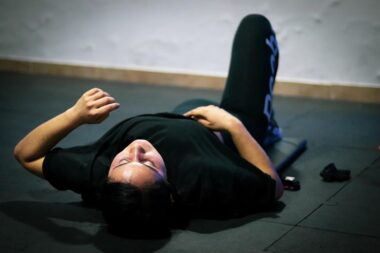The Impact of Neglecting Core Mobility on Training Results
The core is an essential part of the human anatomy, providing stability and support for almost every movement we perform. When individuals neglect core mobility, their training results can suffer significantly. Many athletes and fitness enthusiasts often overlook the importance of incorporating flexibility and mobility work into their core training regimen. This oversight can lead to a range of problems, including reduced performance, increased risk of injury, and imbalances in strength and flexibility. Neglecting core mobility can cause stiffness in the muscles surrounding the spine and pelvis, which directly affects overall body mechanics. This stiffness can result in poor posture, limited range of motion, and decreased athletic performance. Furthermore, when the core lacks mobility, it can compromise the effectiveness of other exercises, as the core must function optimally to transfer power and stability throughout the body. Consequently, it’s vital to prioritize core mobility exercises such as dynamic stretches and foam rolling to enhance flexibility. Engaging in these practices improves functional movement patterns, enabling athletes to perform better, recover faster, and sustain their training over time.
Incorporating core mobility exercises into your routine isn’t just about performance; it’s also a significant injury prevention strategy. Many common injuries in sports and fitness are related to a lack of flexibility and strained muscles, especially in the core region. When core muscles are tight or imbalanced, they can lead to improper movement patterns that inevitably result in injuries. For instance, restricted core mobility can cause undue stress on the lower back during activities such as lifting, running, or jumping. By enhancing mobility, fitness enthusiasts can ensure their muscles have the necessary range of motion to operate effectively in various movements. Transitioning to exercises that promote core mobility, such as bridges, rotating planks, and torso twists, can improve overall function and mitigate pain caused by tightness or rigidity. Moreover, these exercises can accelerate recovery post-workout, aiding in the relief of muscle soreness. Staying consistent with mobility exercises will yield better training results over time, allowing for consistent progress while preventing injury setbacks. Remember to listen to your body; if you experience discomfort in your core, addressing mobility issues should be a priority.
Common Mistakes in Core Mobility Training
One significant mistake people make during core mobility training is neglecting warm-up routines. A proper warm-up prepares the muscles for movement and can significantly prevent injuries. Individuals often jump straight into strenuous core exercises without adequately warming up first. This lack of preparation can lead to muscle strains or injuries, particularly in those with existing tightness or imbalances. Another common oversight is underestimating the value of integrating various core exercises that target both mobility and stability. Focusing solely on static exercises can prevent cores from achieving dynamic flexibility. This is why varying your core workouts with stabilization exercises, like bird dogs and dead bugs, can be incredibly beneficial. Additionally, many individuals are guilty of performing mobility exercises incorrectly. Poor form can result in further injury and limit the effectiveness of the training. Ensuring you understand the correct technique or seeking guidance from a qualified trainer can optimize your core training outcomes. Lastly, failing to incorporate rest and recovery is a pitfall. Recovery is crucial for muscle growth, and without it, your core’s strength and flexibility may stagnate.
Furthermore, many enthusiasts often underestimate the importance of consistency in core mobility training. Skipping sessions or doing them sporadically can yield minimal results. Developing a regular routine that integrates mobility-based exercises will greatly enhance your core strength over time. Focus on dedicating a specific time each week to mobility training; even 10 to 15 minutes can be productive. Consistency not only helps improve flexibility and strength but also builds a better mind-muscle connection. This connection will allow you to become more aware of your movements and how your core engages throughout daily activities or workouts. Additionally, people sometimes forget to pay attention to their breathing during core mobility exercises. Proper breathing techniques can enhance the effectiveness of exercises and promote relaxation. Incorporating breath patterns like diaphragmatic breathing can help in activating deep core stabilizers while executing mobility activities. Integrating visualization techniques during training can also enhance engagement and results. Visualizing the muscle movements during exercises may activate those muscles more during workouts, enhancing overall efficacy. Finding ways to keep your core training routine exciting and varied can further motivate you to stick to your mobility objectives.
Optimizing Core Mobility for Better Performance
To optimize core mobility, individuals should focus on a well-rounded approach that includes both strength training and flexibility exercises. Utilizing a mix of dynamic stretches, foam rolling, and targeted core workouts will promote a balance of strength and mobility. Dynamic stretching, for example, increases blood flow and warms up the muscles effectively before engaging in more strenuous activities. Moreover, incorporating Pilates or yoga into one’s routine can significantly improve core mobility. These disciplines focus heavily on stability, flexibility, and proper alignment while strengthening the core dynamically. Experimenting with different mobility techniques, including resistance bands or stability balls, can also provide novel challenges for the core muscles. Integrating mobility drills into your warm-up phase before workouts will effectively enhance your overall performance. Finally, tracking your progress is vital. Keeping records of your mobility training can showcase improvements and areas needing more attention. This process encourages motivation and accountability as you aim for your training goals. Whether measuring your flexibility or the ability to hold positions longer, tracking ensures steady progression. Mobility improvements open doors to better overall function, strength, and sustained training results.
Furthermore, seeking advice from professional trainers or physical therapists can help tailor a core mobility program that meets individual needs. Every person’s body is unique and requires specific adjustments based on their anatomy and fitness level. Professional guidance helps ensure you are engaging the right muscles and foiling common mistakes. Although self-evaluation is beneficial, having an expert help assess your core function and mobility can provide valuable insights. These professionals can help design a personalized routine focused on improving stability and strength tailored to your needs. Furthermore, understanding how the core integrates with other muscle groups while performing movements is essential. Mistakes in form and technique can lead to imbalances that affect overall performance, so learning to move as an integrated unit is crucial. Incorporating exercises that train the core in various planes of motion will create a more functional body. For instance, lateral movements target different aspects of the core, promoting overall efficiency. Finally, staying patient is key when training for improved core mobility; progress may be slow but remains worth the effort in the long run.
Conclusion: Importance of Core Mobility
In conclusion, neglecting core mobility can have a lasting negative impact on training outcomes. Prioritizing flexibility and incorporating mobility exercises into your routine is essential for optimal performance and injury prevention. Awareness of common mistakes helps athletes and fitness enthusiasts refine their training approaches, ensuring progress. Enhancing core mobility through consistent practice can unlock a range of benefits, including improved strength, posture, and function in daily activities. The road to effective core training requires commitment, guidance, and continual assessment of one’s routine to make necessary adjustments. Employing a balanced approach to core training ensures you avoid pitfalls and enhance your overall health and fitness. By integrating strength, flexibility, and mobility work, individuals can experience the full potential of their core muscles. Improved core function not only benefits athletes but also contributes to better function in non-athletic individuals. There’s no denying that core mobility lays the foundation for a well-rounded fitness journey. Ultimately, attention to core mobility will positively influence various aspects of life, ensuring individuals achieve their desired training results.
In essence, neglecting core mobility leads to suboptimal performance and increases the risk of injury. As the core controls nearly every movement, ensuring its mobility is essential for athletes and fitness enthusiasts. Consistent training that incorporates mobility work can yield significant improvements in flexibility, power, and recovery time. By making core mobility a priority, individuals can maximize their training efficiency, enhance functional movement patterns, and achieve their fitness goals more effectively. Engaging in the core mobility training process will not only raise awareness about proper technique but also instill a deeper understanding of the body’s mechanics. Therefore, it’s crucial to approach core training holistically and not underestimate the power of mobility. Allow yourself to embrace the journey toward improved core mobility by adopting targeted strategies for your personal fitness objectives. Remember, the mind-muscle connection, consistency, and professional insights will help you achieve meaningful results. Make mobility an integral part of your fitness regimen, and you will likely reap the benefits throughout your training journey and beyond.





